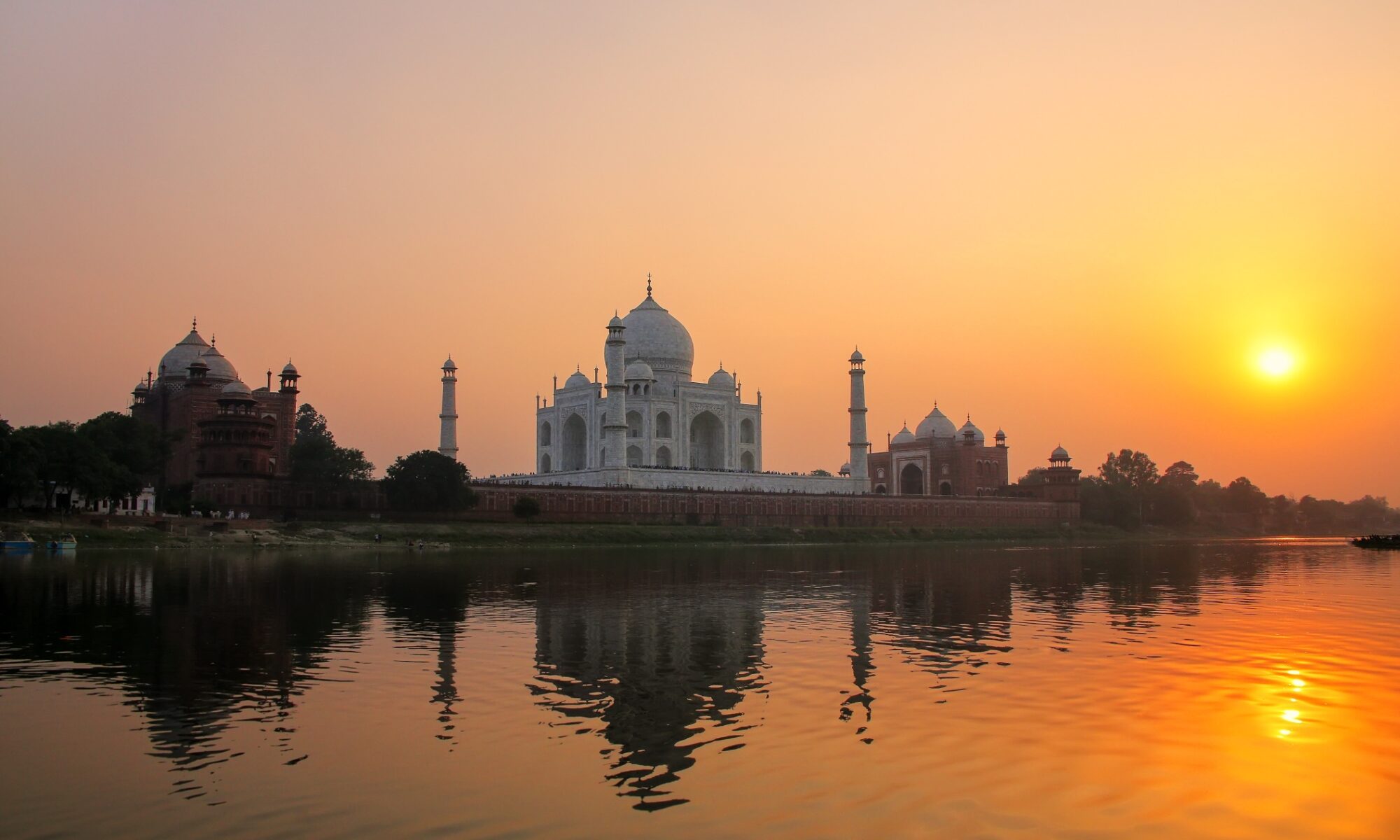TEXTILES OF RAJASTHAN
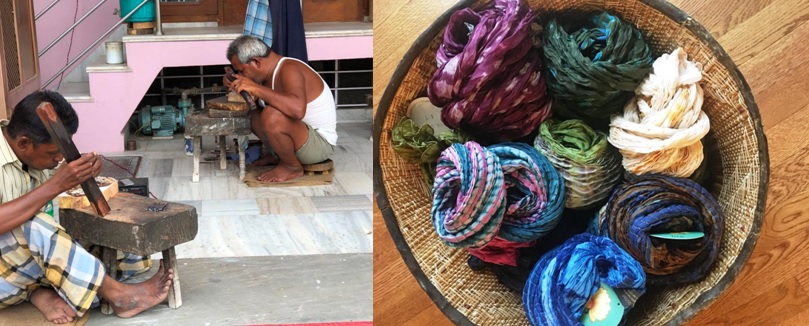
Your itinerary at a glance…..
Day 1: Arrive Delhi. Stay at The Grand New Delhi Hotel for 2 nights.
Day 2: Explore markets of Delhi and enjoy an orientation tour of Delhi
Day 3: Fly to Udaipur. Stay at Amet Haveli for 2 nights. Evening boat ride on Lake Pichola.
Day 4: Full day to explore Lahariya Printing of Udaipur and Dabu Printing of Akola.
Day 6: Drive to Jalore. Stay overnight at Ravla Bhenswara. Visit Moti Bharat textile centre.
Day 7: Drive to Jodhpur. Stay for 2 nights at Indana Hotel.
Day 8: Visit Mehranagarh Fort in the morning. Afternoon we visit textile workshops.
Day 9: Drive to Jaipur visit Bagru workshop en route. Stay at Four Point by Sheraton for 3 nights.
Day 10: Enjoy Holi celebrations today!
Day 11: Morning excursion to Amber Fort. Afternoon visit block printing workshop at Sanganer.
Day 12: Drive to Agra for a night at Crystal Sarovar Premier.
Day 13: Visit Taj Mahal before driving to Delhi. Stay at The Connaught Hotel for 2 nights
Day 14: The day is at leisure to enjoy last minute shopping or visit some sights.
Day 15: Fly back home
TEXTILE TOUR OF RAJASTHAN
Day 01: Arrive Delhi
You will arrive Delhi airport (flight is self-arranged)
You will be met by our representative at the airport exit and transferred to your hotel. You will stay for next two nights at The Grand Hotel. It is a 5-star modern hotel located between city and airport. Remainder of the day is at leisure to recover from long journey.

The Grand Hotel, New Delhi
Delhi Information: Located on the banks of the River Yamuna, Delhi has been continuously inhabited since at least the 6th century BC. After the rise of the Delhi Sultanate, Delhi emerged as a major political, cultural and commercial city along the trade routes between northwest India and the Indo-Gangetic plains. It is the site of many ancient and medieval monuments, archaeological sites and remains. In 1639, Mughal Emperor Shahjahan built a new walled city in Delhi which served as the capital of the Mughal Empire from 1649 to 1857.
After the British East India Company had gained control of much of India during the 18th and 19th centuries, Calcutta became the capital both under Company rule and under the British Raj, until George V announced in 1911 that it was to move back to Delhi. A new capital city, New Delhi, was built to the south of the old city during the 1920s. When India gained independence from British rule in 1947, New Delhi was declared its capital and seat of government. As such, New Delhi houses important offices of the federal government, including the Parliament of India, as well as numerous national museums, monuments, and art galleries.
Owing to the migration of people from across the country, Delhi has grown to be a multicultural, cosmopolitan metropolis. Its rapid development and urbanization, coupled with the relatively high average income of its population, has transformed Delhi. Today, Delhi is a major cultural, political, and commercial center of India.
Day 02: Delhi
Today you will be picked up from your hotel in the morning and to the old quarters of Delhi. This part of Delhi is a major hub of anything famous in India. You start at Kinari Bazaar which is top hunting ground of top end designers. You can find here all the accessories needed for clothes – from simple to top end boutique level. Then you visit the busy, bustling markets of Chandani Chowk which has the best bridal wear shops in India. Later we visit Khan Market – another place for top end, boutique shopping.
In the afternoon, we enjoy an orientation tour of Lutyens’ Delhi. You will drive past Connaught Place – called as Heart of Delhi, and then stop at India Gate. Then you will drive to Raisan Hills to see Rashtrapati Bhawan (President’s Palace) from outside. Beside it is the Parliament of India.
We end the day by visiting a World Heritage Site – Humayun’s tomb. It is a complex of buildings built as the Mughal Emperor Humayun’s tomb, commissioned by Humayun’s wife Hamida Banu Begum in 1562 CE, and designed by Mirak Mirza Ghiyath, a Persian architect. It was the first garden-tomb on the Indian subcontinent, and is located in Nizamuddin East, close to the Dina-panah citadel also known as Purana Qila (old fort), that Humayun founded in 1533. It was also the first structure to use red sandstone at such a scale. The complex was declared a UNESCO World Heritage Site in 1993.
Day 03: Delhi – Udaipur
After a leisurely breakfast, you will be transferred to the airport. Fly to Udaipur.
You will be met at the airport and transferred to your hotel. Stay at Amet Haveli (Lake View Room) for 2 nights.

Amet Haveli, Udaipur
Udaipur information: Maharana Udai Singh founded Udaipur in 1559 AD. According to a legend Udai Singh was guided by a holy man meditating on the hill near Pichola Lake to establish his capital on that very spot. Surrounded by Aravali Ranges, forests and lakes this place was less vulnerable to external invasion than Chittaurgarh. Maharana Udai Singh died in 1572 and was succeeded by Maharana Pratap who valiantly defended Udaipur from Mughal attacks. Maharana Pratap is the most revered Rajput icon who gallantly fought the Mughals at the battle of Haldighati in 1576. Mewar continuously defied foreign invaders and has a history of bloody battles until the British intervention in the nineteenth century when a treaty was signed to protect Udaipur. Upon independence, Udaipur merged with the union of India. Udaipur today is one of the most picturesque cities in Rajasthan with its lakes, hills, and beautiful palace.
Remainder of the day is at leisure to explore Udaipur city. Due to proximity of various lakes and water bodies, Udaipur is also called as “Venice of the East”. Udaipur was the setting of famous James Bond movie – Octopussy. You will enjoy a boat ride (shared seats) on Lake Pichola.
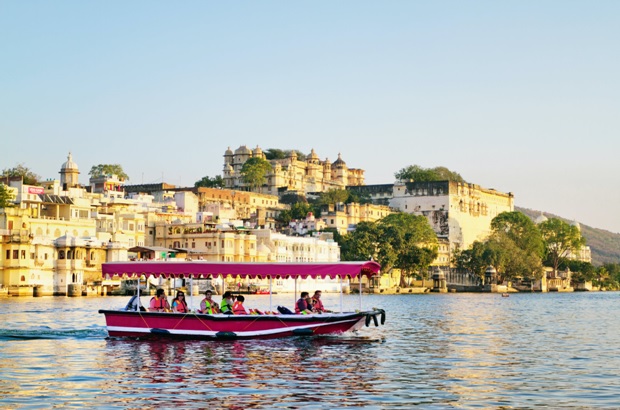
Day 04: Udaipur
Today you visit Akola – a craft cluster near Udaipur. This region is renowned for dabu or mud resist printing. What makes Akola’s Dabu unique is their intricate motifs and premium quality dye. The artisans painstakingly carve the wooden blocks – giving each block a matchless design. The premium quality dye extracted from plants and fruits make these fabrics bleed lesser than the usual ones. What make these families stand out, are their dedication and respect for Indigo printing. Despite the soaring demand, these craftsmen have been deliberately confined to a minimal production quantity per day, to retain the quality of the fabric. Immersing the fabrics in organic dyes, they pay unconditional devotion to each and every fabric they produce. Before the printing process starts, the cloth is thoroughly washed and soaked for 36 hours, to make it soft and absorbable. The fabrics are first drip-dried, then placed on these printing tables, ready for Hand-block printing. Intricately carved hand-blocks, in numerous designs, these are dipped in a mixture of mud and tree gum and are imprinted on the fabrics. Once the block printing is done, the fabrics are dipped in indigo water craters. Then the cloth is washed thoroughly to remove the mud pattern.
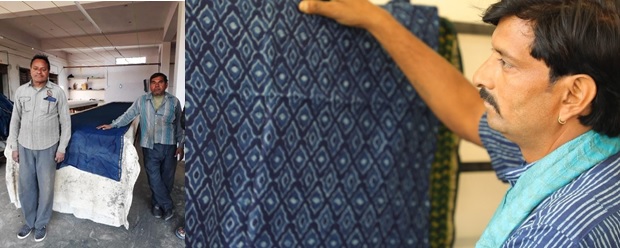
Udaipur is well known for its Lehriya (waves) pattern. This is one of the so many tie and dye patterns that results in wavy pattern, which symbolizes water waves. Lahariya is dyed in different colours. The stripes of different colors are usually arranged diagonally and use two colors are common. The two colors alternate in waves. Originally, the two colors used were the auspicious colors of yellow and red. Turbans, stoles and saris with laheriya are liked and worn all around year but carry a special meaning on and around the time of Teej festival and monsoon.
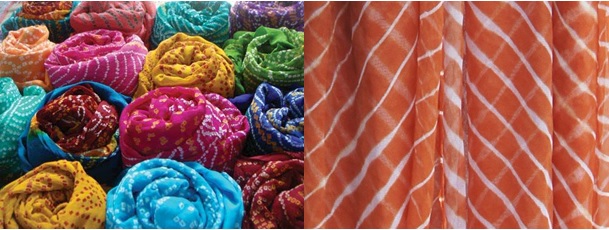
Day 05: Udaipur – Jalore
After breakfast, you will drive for 3-4 hours to Jalore village. Stay overnight at Ravla Bhenswara – a beautiful home of noble family of Jalore.
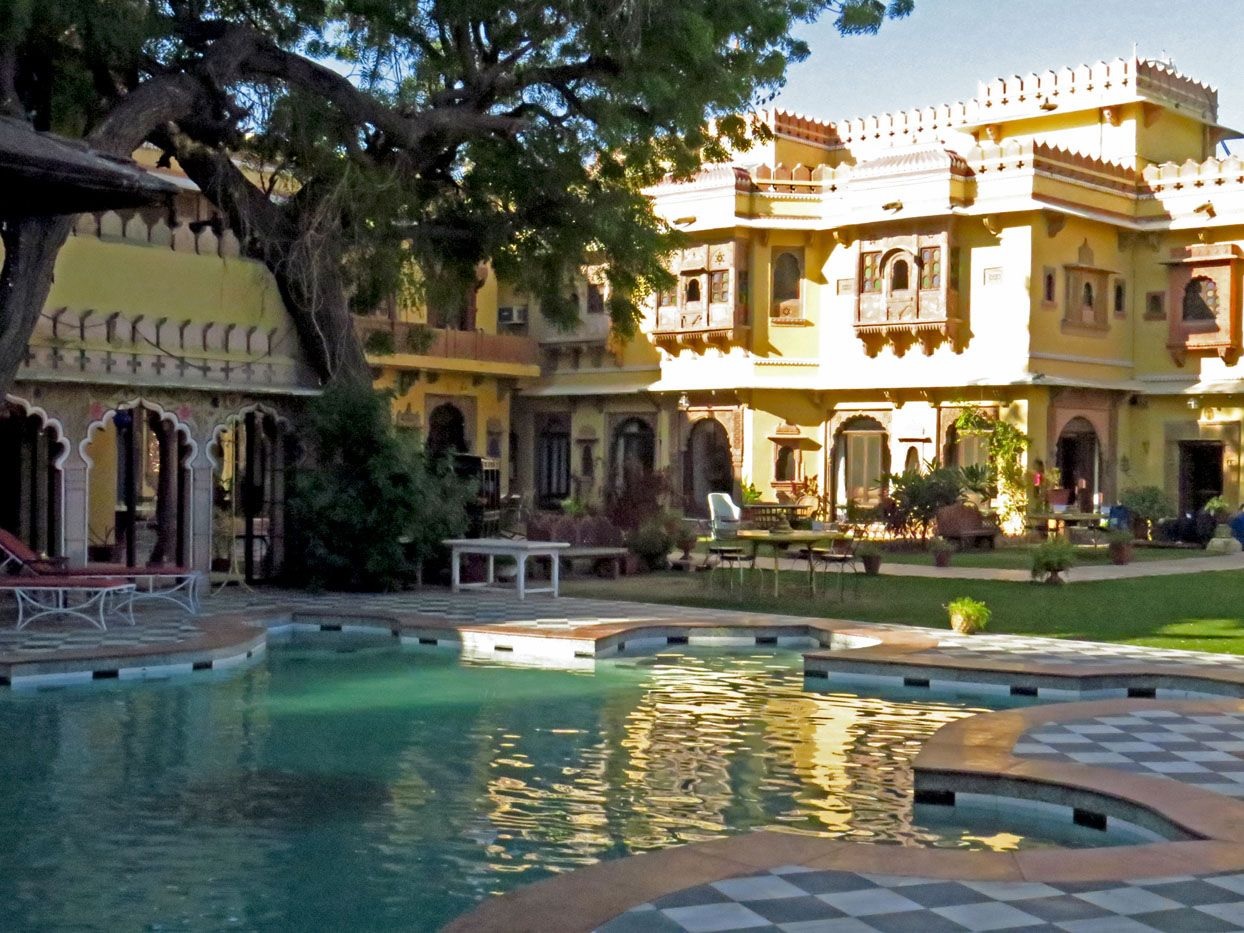
Rawla Bhainswara, Jalore
In the afternoon, we visit the artisans practicing Moti Bharat – a unique textile art found in Jalore. Motibharat is one among those inimitable crafts which is originated in India somewhere in the middle of nineteenth century and predominantly practiced in the Jalor district of Rajasthan but its origin can be traced to the rural part of Gujarat as well. This art extensively used beads on cloth to create interesting patterns. Traditionally the craft was used to make artifacts which are used decorating houses like toran which is used for decorating the main entrance of the house. Wall hangings, small artifacts which are used for token of gift symbolizes luck), fans, toys or decorative artifact in the shape of birds and animals, necklaces, pouches etc. Over the years, artisans have used this art into fashion accessories, brooches, necklaces etc?
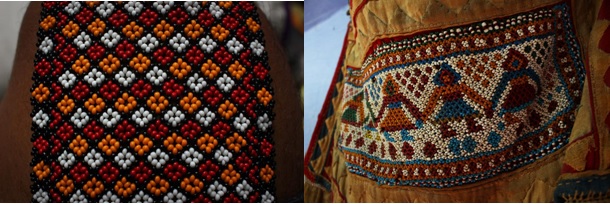
Day 06: Jalore – Jodhpur
Today morning, we drive to Jodhpur – the blue city. We stay for next two nights at Indana Hotel. This is a charming hotel built in character style, swimming pool and good service.

Indana Palace, Jodhpur
Jodhpur is a historic city and the origin dates to the year 1459 AD when it was founded by Rao Jodha, the Rajput chieftan of the Rathores. The Rathore kingdom was also known as the Marwar and was the largest in Rajputana. The city was built as the new capital of the state of Marwar (now Rajasthan) to replace the ancient capital Mandore, the ruins of which can be seen near what is now the Mandore Gardens. The people of Jodhpur and surrounding areas are hence also commonly called as Marwaris. Jodhpur is also known as the Blue City, an apt name as most houses in the old city are shades of blue. This is particularly noticeable on the north side of the town, known as Brahmpuri for the many Brahmins that live there.
Day 07: Jodhpur
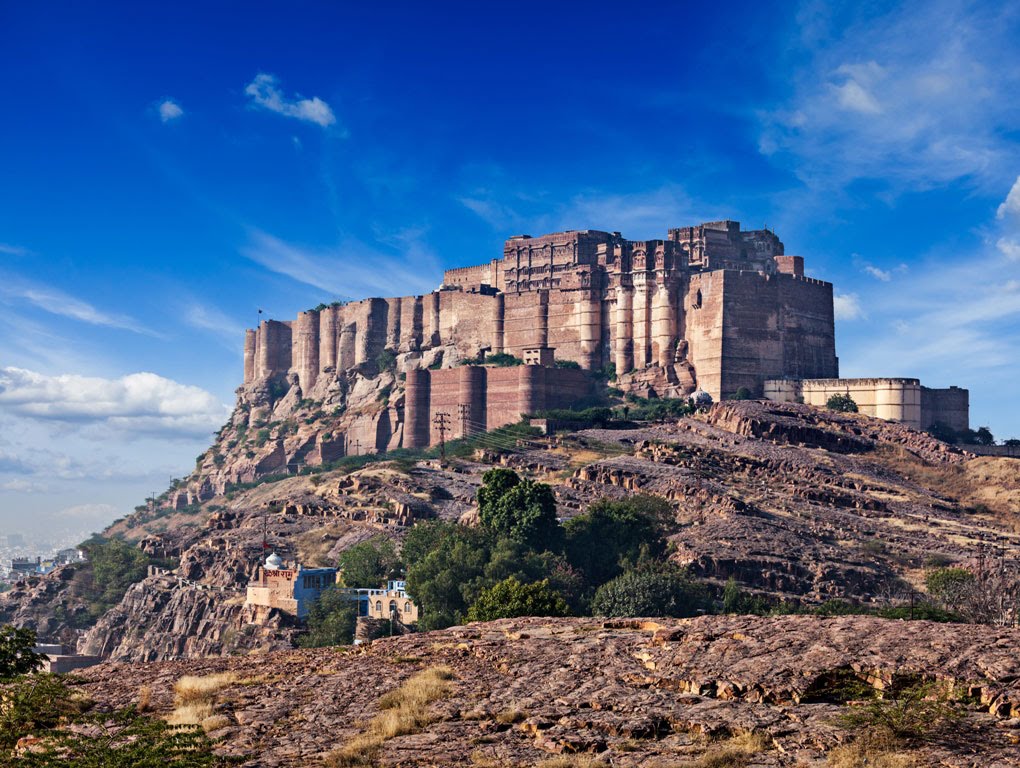
Today morning, we visit the impressive Mehranagarh Fort. It lies in the heart of the old city of Jodhpur and is located atop a 125 m high hill. The magnificent Mehrangarh Fort is the most majestic and one of the largest forts in India. It was originally started (c.1459) by Rao Jodha, founder of Jodhpur. However, most of the extant fort dates from the period of Jaswant Singh (1638-78). The walls of the fort are up to 36 m high and 21 m wide; they enclose some exquisite structures. The fort museum houses an exquisite collection of palanquins, howdahs (elephant seat), royal cradles, miniatures, musical instruments, costumes and furniture. The ramparts of Mehrangarh Fort provide not only excellently preserved cannons but also a breath-taking view of the city.
In the afternoon, we visit the textile workshops in the city. Also visit Salawas – a small village 22 kms from Jodhpur, famous for durries(rugs) made by local craftsman. The durry (rugs) weaved out of cotton or wool. You visit Salawas Durry Udhyog to see the art of making durries. They are weaved on village looms in vibrant designs and motifs. The simplest is in single color with contrasting borders and the more complicated one 5 bore geometric patterns animal’s designs or floral designs in a mix of contrasting color.
Day 08: Jodhpur – Jaipur
Drive to Jaipur early in the morning (6-7 hours). On the way we visit the block printing workshop at Bagru. A small village about 20 miles East of Jaipur, Bagru is famous for traditional hand block printed textile. The craftsmen from various places in Rajasthan – like Sawai Madhopur, Alwar, Junjjhunu and Sikar – migrated to Bagru some 300 years ago. They made it their home, and one of Rajasthan’s most important centers of hand block printing. Bagru is derived from the word ‘Bagora’ – the name of an island in a lake where the city was originally built and is famous for its palm fan and ‘chintz’ (fadat) production pattern. The traditional ‘motifs’ of Bagru have under gone change over the years. But the basic techniques and colors have remained unchanged and unaffected through these centuries. This makes the Bagru prints spectacularly different, distinctive and highly specialized. The local people, particularly the women, mainly used the Bagru prints in the past. Patterns with rich colors like the indigo blue, alizarin, iron block and bright yellow were produced on coarse cotton cloth by indigenous processed of dyeing and printing. In building up patterns, geometrical forms were adopted along with floral, animal and bird forms. Everything seemed to be inspired from local sources. Synthetic dyed have now replaced some natural dyes but their resists, their process and their sequences have hardly under gone any change. The styles and motifs have been adapted to some extent to the changing market pattern Bagru prints are characterized by circular designs, as well as linear and floral patterns.
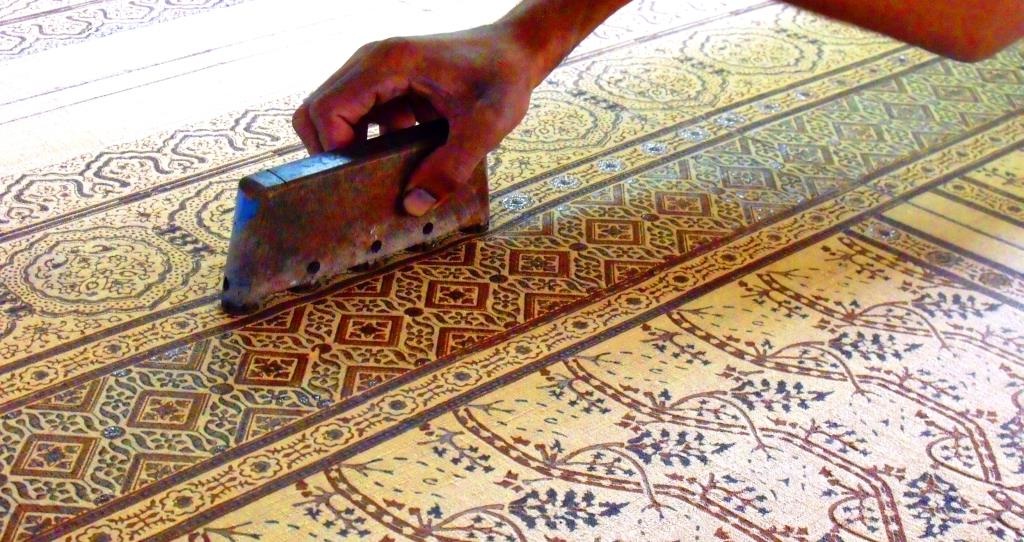
We Carry on to Jaipur and stay for next three nights at Four Points by Sheraton – a comfortable 4-star modern hotel located centrally in Jaipur city.

Four Points by Sheraton, Jaipur
Jaipur, also popularly known as the Pink City, is the capital of the Indian state of Rajasthan. During the British rule in India, Jaipur was the capital of the princely state of Jaipur. Founded on 18 November, 1727 by Maharaja Sawai Jai Singh II, the ruler of Amber, the city today has a population of more than 6 million. Jaipur is the first planned city of India, located in the semi-desert lands of Rajasthan. The city which once had been the capital of the royalty now is the capital city of Rajasthan. The very structure of Jaipur resembles the taste of the Rajputs and the Royal families. At present, Jaipur is a major business centre with all requisites of a metropolitan city.
Day 09: Jaipur
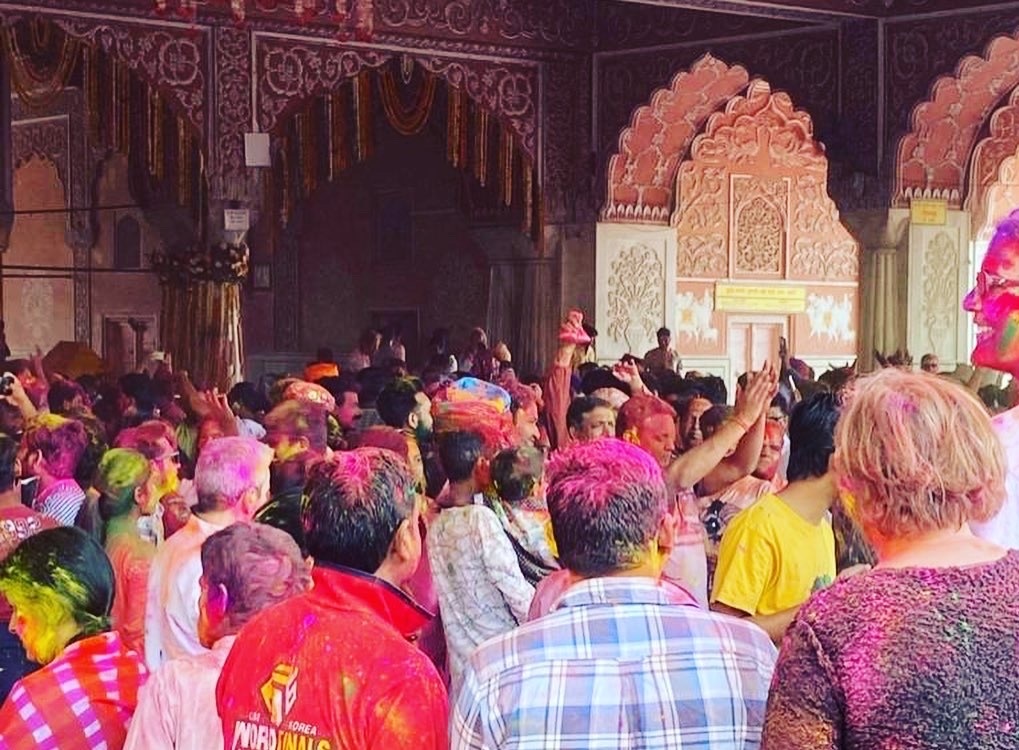
Today is Holi – the festival of Colors! A special celebration is arranged in the hotel, followed by festive lunch. In the evening, we may venture out for a stroll in the colorful markets of Jaipur.
Day 10: Jaipur
Today morning, we will enjoy an excursion to Amber Fort, with a photo stop at the famous ‘Palace of Winds’. The hilltop fort of Amer can be ascended on elephant’s back or in a jeep. The fort was the ancient citadel of the ruling Kachhawa clan of Amber, before the capital was shifted to present day Jaipur. Amber Fort is known for its unique artistic style, blending both Hindu and Muslim (Mughal) elements, and its ornate and breathtaking artistic mastery. Amber Fort is constructed of white and red sandstone. The Fort is unique in that its outside, an imposing and rugged defensive structure, is markedly different from its inside, an ornate, lavish interior influenced by both Hindu and Muslim (Mughal) styles of ornamentation. The walls of the interior of the fort are covered with murals, frescoes and paintings.

Later we will enjoy a camel ride near Amber Fort before returning to the hotel.
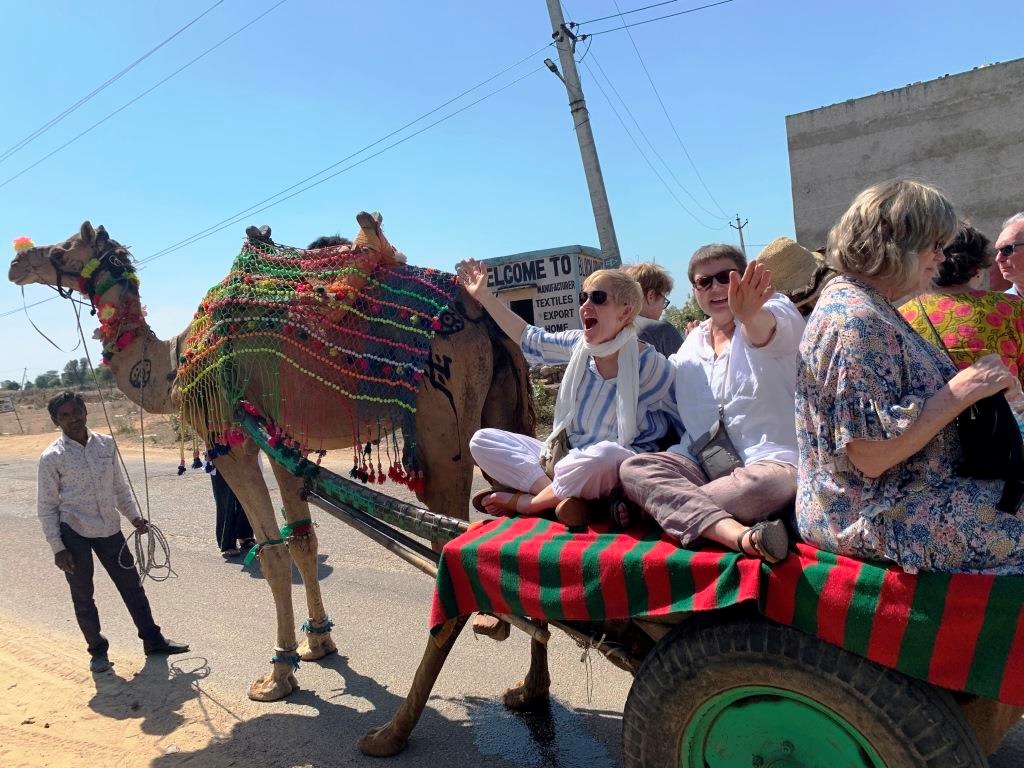
In the afternoon, we visit Sanganer – another village famous for block printing. In both the Sanganer and Bagru prints, the colors are picked carefully. Each has a separate significance. For instance, red is the color of love, yellow of spring, indigo of Lord Krishna, and saffron of the yogi (seer). The wooden blocks that are used are made of teak wood. Traditionally, vegetable dyes made of madder, pomegranate rind, indigo, and turmeric were used. These have now been largely replaced by chemical dyes. Often, the fabric is dyed before it is printed.
The main distinguishing feature between Sanganer and Bagru printing is that Sanganer print is usually done on a white ground, whereas Bagru prints are on an Indigo or a dyed background. Local water also has its effects. In Sanganer water, block comes out in its best dark shade, while at Bagru block comes with a reddish tinge. As water has always been abundant in Sanganer, the washing of cloth has formed the main basis of printing and dyeing as compared to Bagru where water is comparatively scarce.
There are also differences in motifs. Traditionally, motifs printed at Bagru are large with bold line, as compared to Sanganer, where sombre colors and fine lines, intricate detailing is practiced. Sanganeri motifs are naturalistically rendered, with motifs usually based on flowers (like Iris, Rose, Poppy, Marigold, Sunflower) whereas Bagru motifs are more geometric shapes.
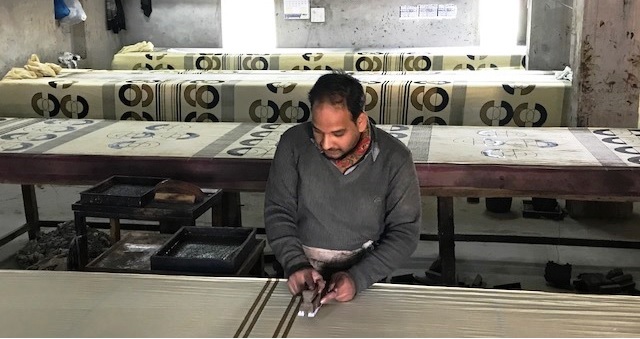
Block Printing Workshop
Day 11: Jaipur – Agra
After breakfast drive for about 5-6 hours to Agra. Your stay for tonight is arranged at Crystal Sarovar Premier – a 4 star modern hotel.
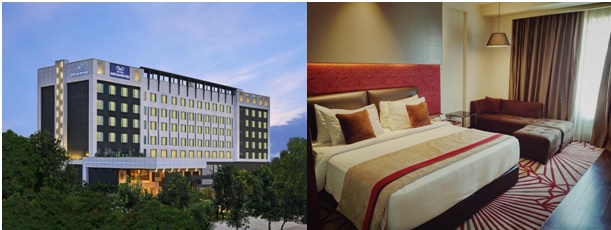
Crystal Sarovar Premier, Agra
Day 12: Agra – Delhi
You will rise early today and head to Taj Mahal to see it before sunrise. Taj Mahal, one of the most famous buildings in the world, is the mausoleum of Shah Jahan’s favorite wife, Mumtaz Mahal. It is one of the New Seven Wonders of the world, and one of three World Heritage Sites in Agra. Completed in 1653, the Taj Mahal was built by the Mughal king Shah Jahan as the final resting place for his beloved wife, Mumtaz Mahal. Finished in marble, it is perhaps India’s most fascinating and beautiful monument. This perfectly symmetrical monument took 22 years (1630-1652) of hard labor and 20,000 workers, masons and jewelers to build and is set amidst landscaped gardens. Built by the Persian architect, Ustad Isa, the Taj Mahal is on the bank of the Yamuna River. It can be observed from Agra Fort from where Emperor Shah Jahan gazed at it, for the last eight years of his life, as a prisoner of his son Aurangzeb. It is an acknowledged masterpiece of symmetry. Verses of the Koran are inscribed on it and at the top of the gate are twenty-two small domes, signifying the number of years the monument took to build. The Taj Mahal was built on a marble platform that stands above a sandstone one. The most elegant dome of the Taj Mahal has a diameter of 60 feet (18 m), and rises to a height of 80 feet (24 m); directly under this dome is the tomb of Mumtaz Mahal. Shah Jahan’s tomb was erected next to hers by his son Aurangzeb. The interiors are decorated by fine inlay work, incorporating semi- precious stones

You will have a leisure time in Agra for some shopping. Late afternoon, you will be driven to Delhi (3-4 hours’ drive). Stay for 2 nights at Taj Connaught Hotel (Superior Room). This first class modern hotel is conveniently located closed to shops and restaurants.
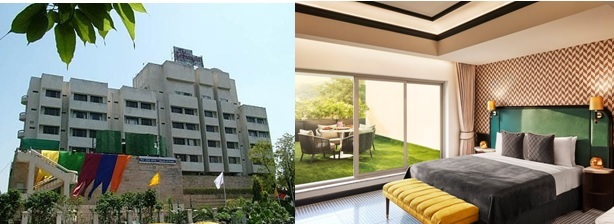
Taj Connaught, New Delhi
Day 13: Delhi
This day is at leisure. You can visit some of the markets again to do last minute shopping – based on your textile experience in Rajasthan. A sightseeing tour of Delhi can also be arranged on local payment.
Day 14: Depart Delhi
At an appropriate time, you will be picked up from your hotel and transferred to international airport (check-in is 3 hours prior). Fly back home with happy memories of Indian Adventure!
*** End of Tour ***
MEAL PLAN: Bed & Breakfast
For Price Contact Us
